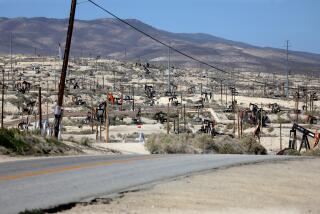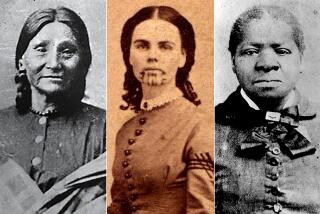Rumbling toward sunset
- Share via
The story of the American West was -- and is -- essentially the story of movement. In “The Old Iron Road,” David Haward Bain sets out to retrace the “extraordinarily resonant and historical corridor” that once carried explorers, emigrants, prospectors, Pony Express riders and rail passengers from the Missouri River to the Golden Gate. For Bain, however, the expedition turns out to be a journey of self-discovery too.
At one point, for example, the author pauses along a stretch of Kansas Highway 7/73 to reflect on an obscure moment in American history that figures crucially in his existence: “Somewhere on this road between Atchison and Leavenworth in eastern Kansas,” he muses, “my grandmother Rose Donahue Haward had been born in a covered wagon in the year 1889.” Thus does Bain humanize the epic tale that he tells in “The Old Iron Road,” and his wholly winning book can be approached (and enjoyed) as history, memoir and travelogue of the highest order.
At every opportunity, he points out the linkages that connect contemporary Americans, famous and obscure, to the places, events and people who figure importantly in our history. “There was a chambermaid in one motel near the Omaha airport, on whose paternal line a great-great-great- had fought to push the Cheyenne away from the tracks out on the Plains as an army bluecoat,” he writes, “and on whose maternal side was a member, far back, of that tribe.”
Bain discloses a telling fact in passing -- he and his family logged some 7,000 miles of travel from east to west in the course of researching his book. That’s because Bain allows himself to wander the back roads and byways just as freely as he wanders in memory and history, and he shuns the interstates in favor of “rolling along the original route of the Union Pacific Railroad, and following the ruts of the wagon pioneers.”
As a result, he is able to share some rare and endangered experiences of the American road -- stopping for lunch at places with names like Mom’s Kitchen rather than McDonald’s, for instance, and skipping the theme parks in favor of a miniature Buffalo Bill’s Wild West Show, a display of some 20,000 hand-carved and painted figures that took a pair of inspired husband-and-wife artisans about 12 years to create. “Not even after bending and peering for an hour,” writes Bain, “did one get a fill of it.”
Wherever he goes, Bain’s eye falls on the odd but illuminating fact of history. As he passes through Atchison, for example, he recalls that Abraham Lincoln once delivered a speech on the same theater stage “that, in four years, would suffer the boot heels of John Wilkes Booth, doing ‘Richard III.’ ” And then he flashes forward a half-century or so to point out that Atchison is also the birthplace of Amelia Earhart, “spirited tomboy and future aviatrix,” who scandalized the local gentry by climbing trees, riding bareback and exploring local Indian caves, an unladylike young lady whose risk-taking predicted her future exploits.
Bain delights in seeking out the humble places of origins of famous people -- Marlon Brando and Malcolm X, Willa Cather and Dick Cavett. He notes that Wyoming has named a state park after sportscaster Curt Gowdy. But he also introduces us to a Nebraska farm boy turned amateur chemist named Edwin E. Perkins, whose inventions included a laxative-based cure for tobacco addiction called “Nix-O-Tine,” a gasoline additive called “Motor-Vigor,” a hair pomade called “Glos-Comb” and a rather more successful concoction of sugar and flavorings, first offered to the public in 1927, which became known as Kool-Aid. Perkins may be a forgotten man, but we learn that in Hastings, Neb., he is still remembered with an annual festival known as Kool-Aid Days.
Bain presents himself as a time traveler, flashing back and forth between the here and now and the dream world of what used to be. “The time is coming, and fast, too,” wrote a young railroad surveyor all the way back in 1868, “when in the sense it is now understood, THERE WILL BE NO WEST.” And, in fact, much of what Bain encounters in his travels is ghostly in one sense or another -- frontier stockades and ICBM sites, fossil beds of extinct dinosaurs and death masks of dead outlaws, abandoned Overland Stage stations and desolate ranches, even “a bare, ruined Roman Catholic cathedral.” On the old Lincoln Highway, he sees a spray-painted sign on a derelict motel that is very much in the spirit of the Old West: “NO TRESPASSING -- SURVIVORS PROSECUTED.”
Bain, a teacher at Middlebury College in Vermont and the author of “Empire Express,” a history of the transcontinental railroad, is accustomed to working on a grand scale, and “The Old Iron Road” is certainly an ambitious and sometimes magisterial undertaking. But it is also intimate and engaging, and I was often reminded of such charming and idiosyncratic books as William Least Heat-Moon’s “Blue Highways” and Reyner Banham’s “Scenes in America Deserta.” Both of these books sent me on quests to see what the authors had seen and described so beguilingly, and I felt the same urge on page after page of “The Old Iron Road.” *
More to Read
Sign up for our Book Club newsletter
Get the latest news, events and more from the Los Angeles Times Book Club, and help us get L.A. reading and talking.
You may occasionally receive promotional content from the Los Angeles Times.






